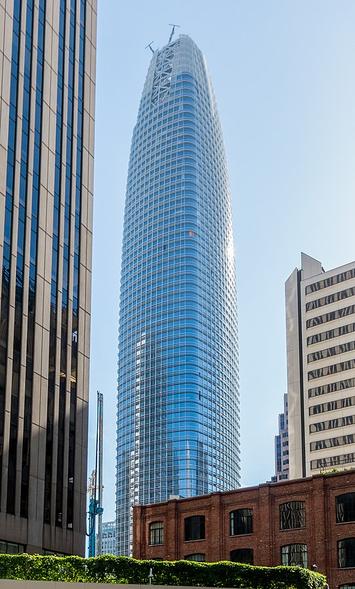
In the 1980s, the city of San Francisco experienced a strong reaction against continued development of its dense financial center skyscraper district north of Market Street. that the term Manhattanization was popularized by the alternative biweekly, San Francisco Bay Guardian, which channeled the interest of many residents to preserve both their neighborhood and the iconic, historic buildings in downtown San Francisco before they were replaced by new, taller structures.
One of the city’s formerly tallest buildings, the Russ Building (completed in 1927), at 435 feet and 31 stories, is a case in point. The Russ Building shared the tallest building honor with the Telephone Building (now 140 New Montgomery), which was the same height but only, 30 stories. The Telephone Building was the tallest building south of Market Street for decades and is visible in Photo 12 taken from the rooftop garden/park (“Salesforce Park”) of the new Salesforce Transit Center.
The Russ Building has long since been surpassed in height by at least 20 new buildings 1986, according to the World Almanac. As late as the early 1960s, only Seattle’s Smith Tower (completed 1909) and the Los Angeles City Hall (completed 1928) exceeded the Russ Building’s height west of Chicago. Photo 1 shows the Russ Building in the background, behind the Pacific Stock Exchange Building and an unimpeded view in Photo 2. A historic streetcar (tram) runs along Market Street in Photo 3.
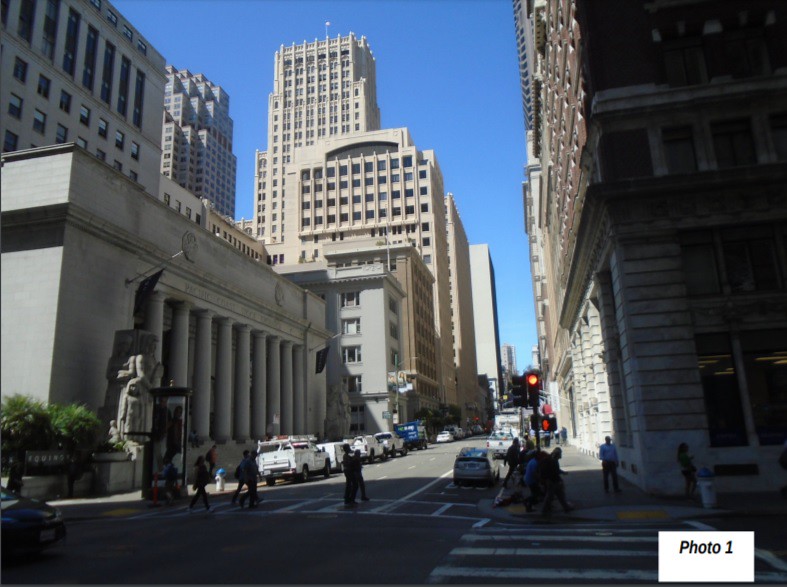

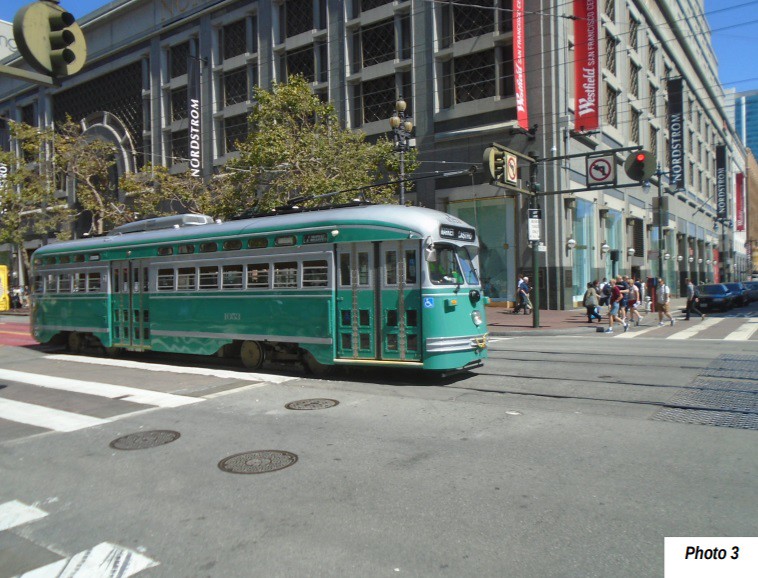
Concerns about Manhattanization led in 1986 to the voter approved Proposition M, which limited the heights of new buildings and the amount of new floor space that could be built. This meant that the new champion, which opened in 1972, the Transamerica Pyramid, remained the city’s tallest for 35 years, about as long as the Russ Building and Telephone Buildings previously held that crown. This is a building that people either tend to love or hate (I am in the latter camp).
South of Market Street (SOMA)
In more recent years, the city has taken advantage of large tracts of well situated, less intensively developed land south of Market Street. “South of Market” or “SOMA” now hosts two of the city’s three tallest buildings, as well as five of the eight tallest (below).
Before 1986, there was relatively little skyscraper development south of Market Street. Photo 4 is a view today taken east down Post Street, through the pre-2000 financial district, capped in the distance by new Salesforce Tower, in SOMA. It is framed on the left by the One Montgomery Building, built in 1982 as the headquarters of Crocker Bank (which was purchased by Wells Fargo Bank), and on the right, by McKesson Plaza, built in 1969, which housed McKesson’s headquarters until their recent move to Dallas-Fort Worth. The white 595 Market Street Building is at the end of Post Street, at Market Street, in front of the Salesforce Tower.

The centerpiece of SOMA is the Salesforce Tower, which at 1070 feet and 61 floors is the tallest in the city (Photos 5 & 6). Only the Wilshire-Grand Tower in Los Angeles is taller west of Chicago, with a spire reaching 1100 feet. The roof of the Salesforce Tower, however higher is than that of the Wilshire-Grand. The Salesforce Tower also obtained naming rights to the new Salesforce Transit Center (which replaced the Transbay Terminal) and funded amenities in the transit center.
The city’s third tallest building, 181 Fremont is 56 floors and 802 feet. It is a mixed use residential and office tower (Photos 5 & 7).
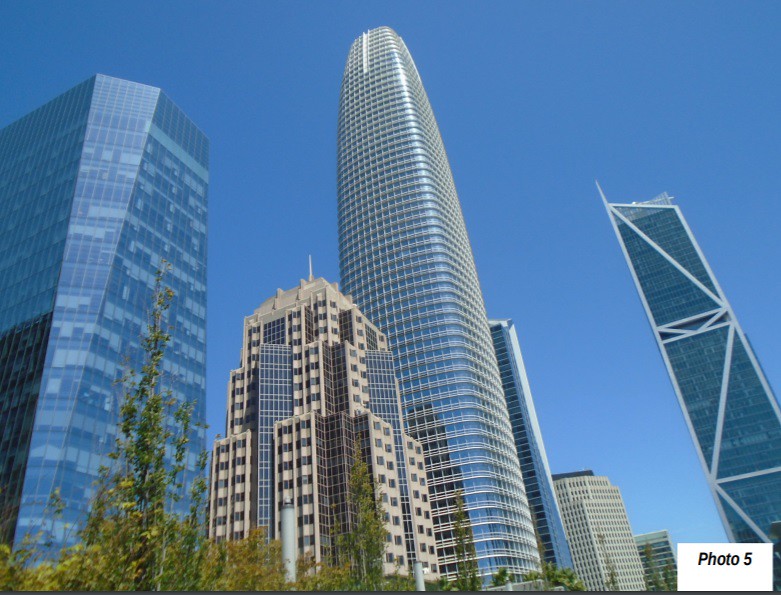
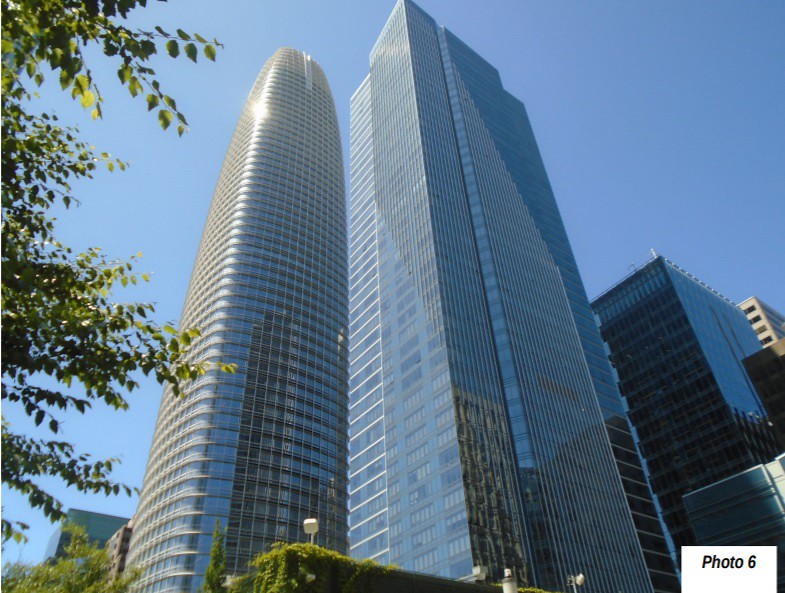

Just to the east of the Salesforce Tower stands the Millennium Tower, a luxury condominium building. It is the sixth tallest in the city, at 58 floors and 645 feet tall. The building has received considerable unwanted publicity as a result of tilting that could take up to $500 million to correct. Not surprisingly, tenants are not happy. The Millennium Tower developers are suing the public agency owners of the Salesforce Transit Center (the Transbay Joint Powers Authority), claiming, according to Business Insider, that “construction workers pumped too much water out of the ground while the transit center was being built, causing the sand to compress and the tower to sink.” The Millennium Tower is on the right in Photo 6, with the Salesforce Tower on the left.
The 8th tallest Park Tower is a unique design, rising to 600 feet and 43 floors (Photo 9), located to the north of the Avery, which is 575 feet and 56 floors.
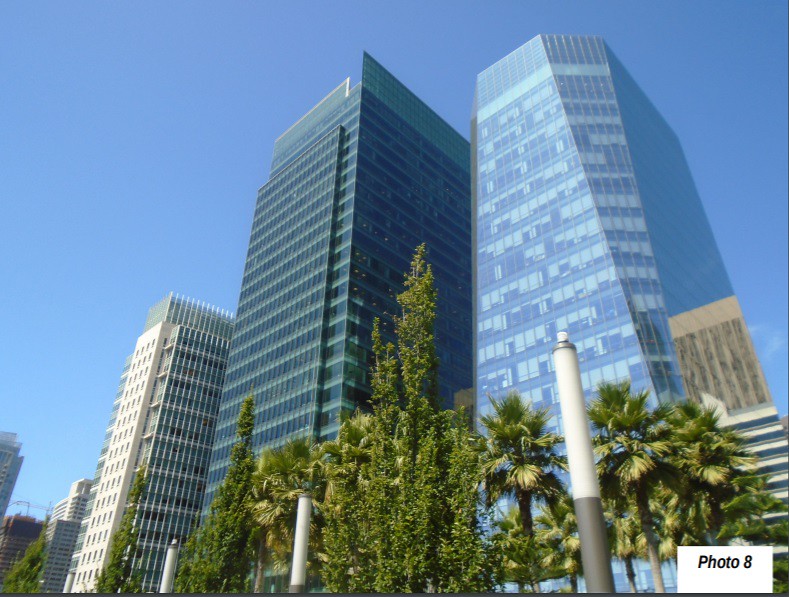

Off-ramps from the San Francisco-Oakland Bay Bridge are visible (Photo 10) and the 101 California Street Building can be seen in the distance on Market Street (Photo 11). Photo 12 shows the formerly tallest Telephone Building.

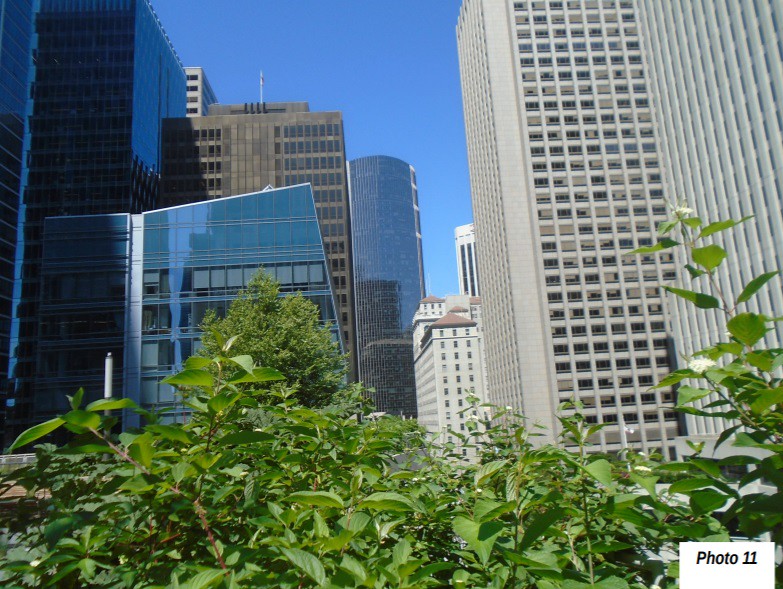
The last next photos were taken while walking to the south of the Transit Center, toward the San Francisco-Oakland Bay Bridge. The two Lumina condominium buildings are shown in Photo 13. The Mira SF condominium tower is a unique angular design (Photo 14). Photo 15 shows San Francisco-Oakland Bay Bridge from Rincon Hill (Harrison Street), as it crosses to Yerba Buena Island.



Salesforce Transit Center
The Salesforce Transit Center is one of the busier locations in downtown San Francisco. It stretches for four blocks as a terminal for San Francisco Municipal Railway buses, suburban buses and is planned to be the terminal for Caltrain commuter rail services from the Peninsula and Santa Clara County. Eventually it may also serve high-speed rail trains, though, given that project’s troubled history, that is uncertain. As is typical for major infrastructure projects, the Salesforce Transit Center experienced nearly 50% cost escalation, with the planned $1.6 billion project escalating to $2.3 billion. The outside and inside of the terminal are shown in Photos 17 and 18. Photo 19 shows a bus bay.

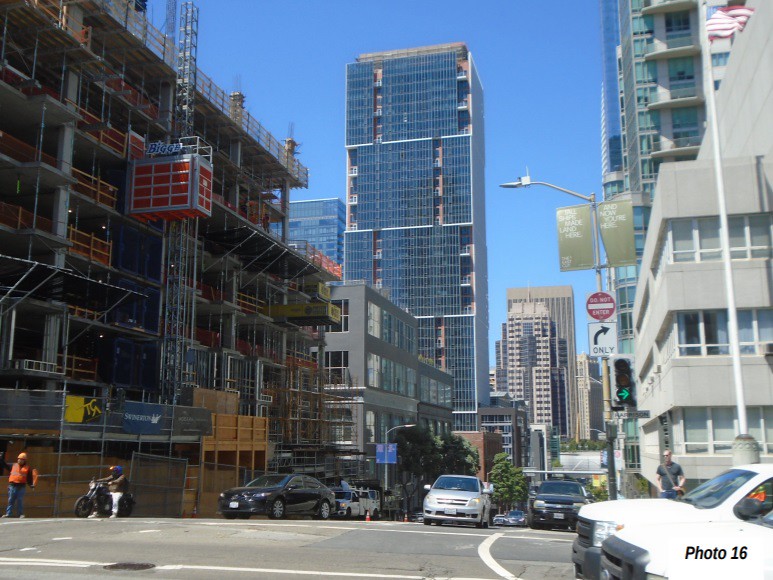
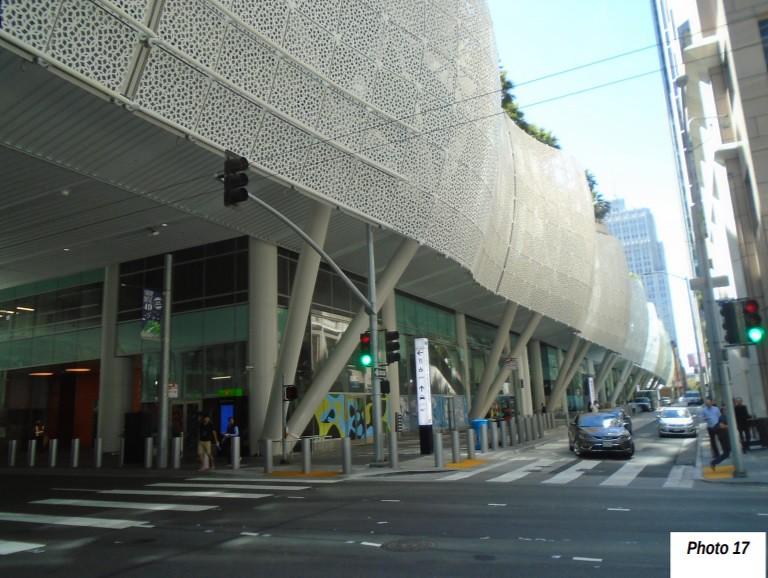
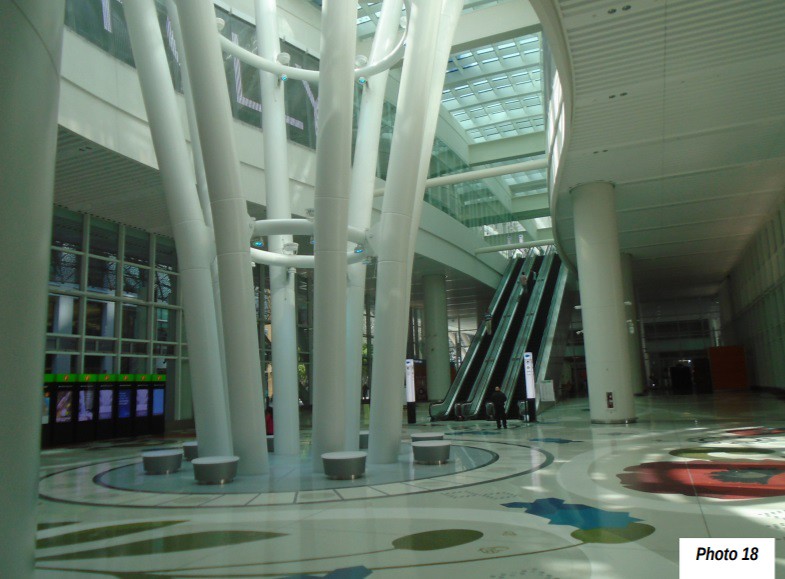

The Salesforce Transit Center, like the Millennium Tower, has experienced structural difficulties, with two cracked beams discovered early after its 2018 opening. This resulted in a closure from September 2018 to July 2019.
Salesforce Park, has places to walk, sit or picnic and a large area used by visitors at lunch, at least on sunny summer days (Photo 20) Photos 5 through 12 were all taken from the roof garden of the Salesforce Transit Center.

SOMA in Context
SOMA has developed into a major addition to downtown, but with considerably less building density and more open space. In a way it reminded me of other, newer downtown additions, such as Chicago’s North Michigan Avenue and River North, with its mix of older buildings and new towers, all considerably more sparsely developed than the Loop. The contrast with the financial district is similar to the old central business district of Buenos Aires and the newer, less intense development in the high-tech district, adjacent to the northeast.
South of Market growth is part of the reason that the city of San Francisco has a larger population than in 1950, one of only three major metropolitan area historical core municipalities achieving that without material annexations (the others being New York and Oakland). Even so , the bulk of the Bay Area’s growth continues to be suburban. From 2010 to 2018, the city accounted for 10.5 percent of the population growth in the San-Jose—San Francisco combined statistical area (CSA), only slightly more than the city’s share of 2010 CSA population Perhaps even more significant is that with all of the employment growth in SOMA, part of the nation’s fourth largest central business district (downtown), 89 percent of the employment is elsewhere in the CSA.
A walking tour South of Market shows high-density neighborhoods that are attractive to their own demographic, as is the case from the core to suburbia to exurbia. Moreover, the park at the top of the transit center is well worth a visit, even if you don’t arrive by bus.
Wendell Cox is principal of Demographia, an international public policy and demographics firm. He is a Senior Fellow of the Center for Opportunity Urbanism (US), Senior Fellow for Housing Affordability and Municipal Policy for the Frontier Centre for Public Policy (Canada), and a member of the Board of Advisors of the Center for Demographics and Policy at Chapman University (California). He is co-author of the "Demographia International Housing Affordability Survey" and author of "Demographia World Urban Areas" and "War on the Dream: How Anti-Sprawl Policy Threatens the Quality of Life." He was appointed by Mayor Tom Bradley to three terms on the Los Angeles County Transportation Commission, where he served with the leading city and county leadership as the only non-elected member. Speaker of the House of Representatives appointed him to the Amtrak Reform Council. He served as a visiting professor at the Conservatoire National des Arts et Metiers, a national university in Paris.
Top photograph: Salesforce Tower
Creative commons: https://commons.wikimedia.org/wiki/File:Salesforce_Tower_SF_2017.jpg












